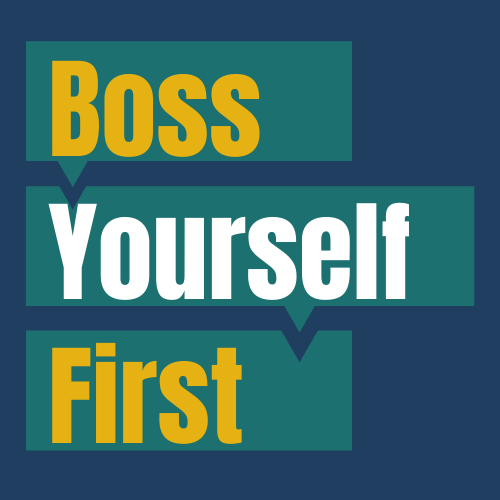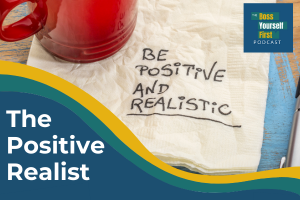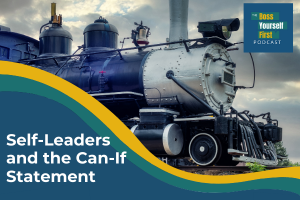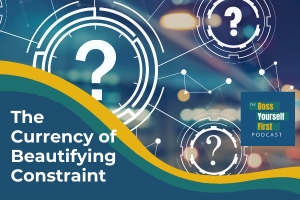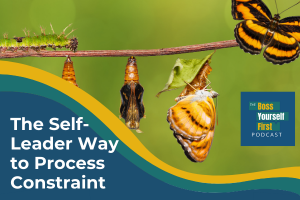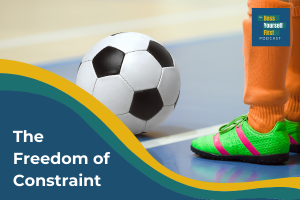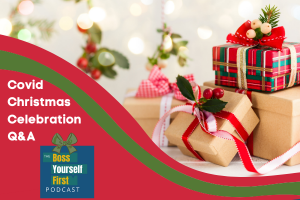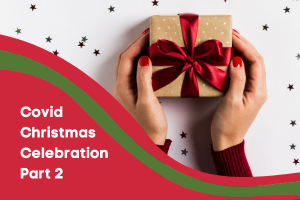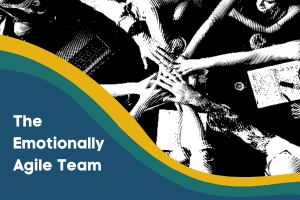The Positive Realist
On today’s episode, we’re taking a close look at mental contrast – a method that uses both positive and still realistic visioning to create desired results. We’re still working on processing constraint but understanding this method will help us create motivation for that process. Today you’ll learn the WOOP method to pursue your goals and be sure to pick up a WOOP worksheet at bossyourselffirst.com under this episode.
Episode Transcript
Boss Yourself First –
BYF Season 2 Episode 6
Hello friends. I hope you are well. If you’re here in the US, chances are you’ve had some pretty intense weather situations of late. So, I hope you are all safe and warm. We’re on episode 6 of our season talking about constraint which we’re defining as a limitation or parameter imposed by outside circumstances or ourselves that inspire innovation and creativity to accomplish a desired result. And like I said, we’re 6 weeks in so far, we’ve talked about what a constraint is and the freedom to focus it can provide, we’ve discussed the stages of processing constraint and worked on our question thinking to move through those stages, we’ve talked about the propelling question and the power of the can-if statements as a framework for innovation and last week we talked about building an abundance mentality as we look at resources to leverage constraint. It has been a great journey so far, because these episodes build on each other, I would encourage you to go back if you missed one, so you get the whole picture. Today we’re bringing back a familiar topic because we spent our first season exploring emotions. And then we were specifically looking at how to build emotional agility. Today though, we are looking at bringing in the motivating power of emotions into the process of leveraging constraint
I shared with you all that my youngest daughter has recently completed the college application process and in talking through questions from application, I asked her to describe herself. She said that she is a realistic optimist. And I think my young padawan may have articulated a key viewpoint for today’s work here on the podcast. Where we’re looking at the power of positivity linked to the realistic view of obstacles as we process constraint.
This shows up in a practice called mental contrasting. Before we dive into this explanation of mental contrasting, you might be asking how this practice ties into processing constraint. Well, I’m so glad you asked. The authors of our book for this season, a beautiful constraint built upon the technique of mental contrasting to build sustaining emotional motivation to the process of making constraint beautiful in pursuit of a goal or result. So I promise it fits but I want you to understand what mental contrasting and discover how to use it for yourselves. We go for practical self-leadership application here on Boss yourself first so let’s learn about mental contrasting. This technique was created by Gabriele Oettingen in 1999 as positive psychology was really building momentum. She decided to put positive thinking to the test. The basic framework of her many experiments around this were to have a group focus on their goal and really imagine what it would be like to achieve that goal. They really captured a vision for getting the desired results and when they felt motivation fading, they refocused on their vision. She compared that group to another group who really spent time visioning obstacles that could stop them from getting their goal, one more group was entered into the comparison, a group that did both positive visioning and realistic visioning of obstacles. Both the wholly positive and the wholly negative groups were much less likely to stay the course and achieve their goals. The group that succeeded most was the hybrid group that did both. Like my daughter, positive realists. When they lost motivation around their goal, they revisited this vision of facing obstacles. Dr. Oettingen was surprised when the process of comparing and contrasting these positive and negative aspects of future desired results is what is known as mental contrasting
In an article for the NY Times Oettingen says, “Positive thinking is pleasurable, but that doesn’t mean it’s good for us. Like so much in life, attaining goals requires a balanced and moderate approach, neither dwelling on the downsides nor a forced jumping for joy.”
Now we’ll talk in our next episode about how Barden and Morgen, the authors of A beautiful Constraint use mental contrasting in processing constraint. I want to spend the rest of our time today on how you can use mental contrasting with our goals.
Dr. Oettingen created a method called WOOP that I’m going to walk through with you here and I’ll have a downloadable worksheet for you on my website that can help you give it a try. Also. Dr. Oettingen’s website offers some fantastic resources if you want to explore a little further.
I really like this method, it’s basically self-coaching, this is a lot of what a coach does with her clients. We look at desired results, we look at what needs to happen to get the results, we plan for obstacles yes, it’s great to have a coach with you through this process and a coach can bring their own observations to help you explore but you my friends as self-leaders can take on this work on your own. I would recommend you add some support resources and accountability but the WOOP method is a great starting point.
What is your wish? Is it professional, relational, self-leadership? You may come up with several, pick the one that feels the most important. The one that would have the greatest impact on multiple areas of your life. Your wish needs to meet three criteria – is it important to you? Is it a challenge? Is it something you can accomplish? Choose a wish that is within your power to fulfill in a relatively short time – meaning two or three months. If your wish is bigger than try to break it into smaller wishes. Capture your wish in just a few words and record them on the next page.
What is the best outcome of that wish being fulfilled?
Really take time to imagine the outcome. What would it accomplish? How would you feel having that wish fulfilled? Capture those outcome feelings in just a few words and record them on the next page.
What is the obstacle within you that keeps you from fulfilling that wish?
This may take a couple of layers to get down to the real obstacle. The key here is “within you” because first you’re going to say I’m busy or lack of time, but you know that we make the time for the things that are important. How we use our time tells us what our real priorities are. So dig deeper. What is the obstacle within you that keeps you from fulfilling the wish?
Now really imagine that obstacle showing up. What do you feel when that obstacle shows up? Capture the obstacle in just a few words and record them on the next page.
Now we plan. With if then statements.
What can you do to overcome the obstacle you’ve visioned?
What is one thing you can tell yourself to overcome it?
What is one action to help yourself overcome it?
Put those strategies into “IF-Then” Statements
If (obstacles) show up then I will tell myself (strategy 1).
If (obstacles) show up then I will (strategy 2).
Generate your “if-then” statements and record them on the next page. These are not to be confused with the Can if statements of processing constraint although I bet Barden and Morgan were inspired by the if can statements in WOOP. These are your tools that you can whip out if obstacles show up.
When you feel your energy flagging toward fulfilling your wish circle back to the words in your visions. When you encounter obstacles, Work your plan.
Let’s work through a scenario to see how this plays out.
Frequently, the most dear wish, especially as shorts and swimsuit season approaches is to get more fit maybe lose some inches and have more energy.
Let’s say the wish is to get more fit.
Outcome – I would have more energy to do things with my family, I would feel better in my clothes, I would be stronger. I would feel confident and graceful. I picture myself leaving the house because hopefully 2021 will hold more of the leaving the house. So, I’m leaving the house and going for a long walk with my dog along the river near my home. I’m smiling, feeling good.
Obstacles within me – letting myself be distracted from my workouts and eating non-nutritive food, what is it really? Lack of belief that I can really get there and be more fit.
Plan – When I feel a lack of belief that shows up as being distracted and not eating well, I will tell myself, it’s okay, I still believe in you.
When I feel my obstacles show up, I will prove my belief by getting a brief two minutes of movement and a glass of water.
I hope you try it, remember I have a WOOP Worksheet for you at boss yourself first.com under the resources for this episode. Try it and tell me about it at the website, on Facebook in the boss yourself first Facebook group or DM me on Instagram. In fact, I host a Facebook live for the Boss Yourself First Facebook Group every Monday at 8:00am Mountain time and next Monday I’m going to lead a WOOP session. It will only take about five minutes, but you’ll get to work through your WOOP worksheet with me. So, join the group and I’ll get to see you there.
I’m going to close us out today with a couple of quotes.
“Mental contrasting is a reality-bound and solution-focused practice that may help you and your clients reach new heights with unwavering motivation, even in the face of life’s biggest challenges. We strongly encourage you to give the practice a try.Positive thinking fools our minds into perceiving that we’ve already attained our goal, slackening our readiness to pursue it. “Gabriele Oettingen
And the last quote is from Viktor Frankl, we tapped into his wisdom in season one and here he is again as one of my favorite thought leaders. He says, “Our answer must consist, not in talk and meditation, but in right action and in right conduct. Life ultimately means taking the responsibility to find the right answer to its problems and to fulfill the tasks which it constantly sets for each individual.”
In other words, my friends, get out there and take action, use the WOOP method make a plan, get going and boss yourself first.
Talk to you next week, take care everyone.
